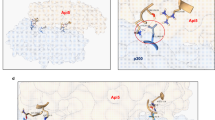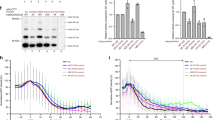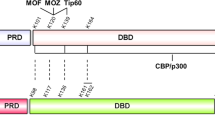Abstract
Cyclin A accumulates at the onset of S phase, remains high during G2 and early mitosis and is degraded at prometaphase. Here, we report that the acetyltransferase P/CAF directly interacts with cyclin A that as a consequence becomes acetylated at lysines 54, 68, 95 and 112. Maximal acetylation occurs simultaneously to ubiquitylation at mitosis, indicating importance of acetylation on cyclin A stability. This was further confirmed by the observation that the pseudoacetylated cyclin A mutant can be ubiquitylated whereas the nonacetylatable mutant cannot. The nonacetylatable mutant is more stable than cyclin A WT (cycA WT) and arrests cell cycle at mitosis. Moreover, in cells treated with histone deacetylase inhibitors cyclin A acetylation increases and its stability decreases, thus supporting the function of acetylation on cyclin A degradation. Although the nonacetylatable mutant cannot be ubiquitylated, it interacts with the proteins needed for its degradation (cdks, Cks, Cdc20, Cdh1 and APC/C). In fact, its association with cdks is increased and its complexes with these kinases display higher activity than control cycA WT–cdk complexes. All these results indicate that cyclin A acetylation at specific lysines is crucial for cyclin A stability and also has a function in the regulation of cycA-cdk activity.
This is a preview of subscription content, access via your institution
Access options
Subscribe to this journal
Receive 50 print issues and online access
$259.00 per year
only $5.18 per issue
Buy this article
- Purchase on Springer Link
- Instant access to full article PDF
Prices may be subject to local taxes which are calculated during checkout







Similar content being viewed by others
References
Abramova MV, Pospelova TV, Nikulenkov FP, Hollander CM, Fornace Jr AJ, Pospelov VA . (2006). G1/S arrest induced by histone deacetylase inhibitor sodium butyrate in E1A + Ras-transformed cells is mediated through down-regulation of E2F activity and stabilization of beta-catenin. J Biol Chem 281: 21040–21051.
Baek SY, Kim SR, Bae MK, Hwang JW, Kim JS, Choi YH et al. (2006). Trichostatin A increases the thermosensitivity of human glioblastoma A172 cells. Neurosci Lett 396: 230–234.
Bloom J, Cross FR . (2007). Multiple levels of cyclin specificity in cell-cycle control. Nat Rev Mol Cell Biol 8: 149–160.
Canela N, Orzaez M, Fucho R, Mateo F, Gutierrez R, Pineda-Lucena A et al. (2006). Identification of an hexapeptide that binds to a surface pocket in cyclin A and inhibits the catalytic activity of the complex cyclin-dependent kinase 2-cyclin A. J Biol Chem 281: 35942–35953.
den Elzen N, Pines J . (2001). Cyclin A is destroyed in prometaphase and can delay chromosome alignment and anaphase. J Cell Biol 153: 121–136.
Donzelli M, Squatrito M, Ganoth D, Hershko A, Pagano M, Draetta GF . (2002). Dual mode of degradation of Cdc25 A phosphatase. EMBO J 21: 4875–4884.
Fang G, Yu H, Kirschner MW . (1998). Direct binding of CDC20 protein family members activates the anaphase-promoting complex in mitosis and G1. Mol Cell 2: 163–171.
Fung TK, Yam CH, Poon RY . (2005). The N-terminal regulatory domain of cyclin A contains redundant ubiquitination targeting sequences and acceptor sites. Cell Cycle 4: 1411–1420.
Furuno N, den Elzen N, Pines J . (1999). Human cyclin A is required for mitosis until mid prophase. J Cell Biol 147: 295–306.
Galbiati L, Mendoza-Maldonado R, Gutierrez MI, Giacca M . (2005). Regulation of E2F-1 after DNA damage by p300-mediated acetylation and ubiquitination. Cell Cycle 4: 930–939.
Geley S, Kramer E, Gieffers C, Gannon J, Peters JM, Hunt T . (2001). Anaphase-promoting complex/cyclosome-dependent proteolysis of human cyclin A starts at the beginning of mitosis and is not subject to the spindle assembly checkpoint. J Cell Biol 153: 137–148.
Glotzer M, Murray AW, Kirschner MW . (1991). Cyclin is degraded by the ubiquitin pathway. Nature 349: 132–138.
Gong D, Pomerening JR, Myers JW, Gustavsson C, Jones JT, Hahn AT et al. (2007). Cyclin A2 regulates nuclear-envelope breakdown and the nuclear accumulation of cyclin B1. Curr Biol 17: 85–91.
Gu W, Roeder RG . (1997). Activation of p53 sequence-specific DNA binding by acetylation of the p53 C-terminal domain. Cell 90: 595–606.
Hagting A, den Elzen N, Vodermaier HC, Waizenegger IC, Peters JM, Pines J . (2002). Human securin proteolysis is controlled by the spindle checkpoint and reveals when the APC/C switches from activation by Cdc20 to Cdh1. J Cell Biol 157: 1125–1137.
Hecht A, Laroche T, Strahl-Bolsinger S, Gasser SM, Grunstein M . (1995). Histone H3 and H4 N-termini interact with SIR3 and SIR4 proteins: a molecular model for the formation of heterochromatin in yeast. Cell 80: 583–592.
Imhof A, Yang XJ, Ogryzko VV, Nakatani Y, Wolffe AP, Ge H . (1997). Acetylation of general transcription factors by histone acetyltransferases. Curr Biol 7: 689–692.
Jeong JW, Bae MK, Ahn MY, Kim SH, Sohn TK, Bae MH et al. (2002). Regulation and destabilization of HIF-1alpha by ARD1-mediated acetylation. Cell 111: 709–720.
Klotzbucher A, Stewart E, Harrison D, Hunt T . (1996). The ‘destruction box’ of cyclin A allows B-type cyclins to be ubiquitinated, but not efficiently destroyed. EMBO J 15: 3053–3064.
Leduc C, Claverie P, Eymin B, Col E, Khochbin S, Brambilla E et al. (2006). p14ARF promotes RB accumulation through inhibition of its Tip60-dependent acetylation. Oncogene 25: 4147–4154.
Li M, Luo J, Brooks CL, Gu W . (2002). Acetylation of p53 inhibits its ubiquitination by Mdm2. J Biol Chem 277: 50607–50611.
Linares LK, Kiernan R, Triboulet R, Chable-Bessia C, Latreille D, Cuvier O et al. (2007). Intrinsic ubiquitination activity of PCAF controls the stability of the oncoprotein Hdm2. Nat Cell Biol 9: 331–338.
Malumbres M, Barbacid M . (2005). Mammalian cyclin-dependent kinases. Trends Biochem Sci 30: 630–641.
Martinez-Balbas MA, Bauer UM, Nielsen SJ, Brehm A, Kouzarides T . (2000). Regulation of E2F1 activity by acetylation. EMBO J 19: 662–671.
Morgan DO . (1997). Cyclin-dependent kinases: engines, clocks, and microprocessors. Annu Rev Cell Dev Biol 13: 261–291.
Nagy Z, Tora L . (2007). Distinct GCN5/PCAF-containing complexes function as co-activators and are involved in transcription factor and global histone acetylation. Oncogene 26: 5341–5357.
Nilsson J, Yekezare M, Minshull J, Pines J . (2008). The APC/C maintains the spindle assembly checkpoint by targeting Cdc20 for destruction. Nat Cell Biol 10: 1411–1420.
Pagano M, Draetta G . (1991). Cyclin A, cell cycle control and oncogenesis. Prog Growth Factor Res 3: 267–277.
Parry DH, O’Farrell PH . (2001). The schedule of destruction of three mitotic cyclins can dictate the timing of events during exit from mitosis. Curr Biol 11: 671–683.
Patel JH, Du Y, Ard PG, Phillips C, Carella B, Chen CJ et al. (2004). The c-MYC oncoprotein is a substrate of the acetyltransferases hGCN5/PCAF and TIP60. Mol Cell Biol 24: 10826–10834.
Ramachandran V, Matzkies M, Dienemann A, Sprenger F . (2007). Cyclin A degradation employs preferentially used lysines and a cyclin box function other than Cdk1 binding. Cell Cycle 6: 171–181.
Resnitzky D, Hengst L, Reed SI . (1995). Cyclin A-associated kinase activity is rate limiting for entrance into S phase and is negatively regulated in G1 by p27Kip1. Mol Cell Biol 15: 4347–4352.
Rosenberg AR, Zindy F, Le Deist F, Mouly H, Metezeau P, Brechot C et al. (1995). Overexpression of human cyclin A advances entry into S phase. Oncogene 10: 1501–1509.
Sadoul K, Boyault C, Pabion M, Khochbin S . (2008). Regulation of protein turnover by acetyltransferases and deacetylases. Biochimie 90: 306–312.
Sakaguchi K, Herrera JE, Saito S, Miki T, Bustin M, Vassilev A et al. (1998). DNA damage activates p53 through a phosphorylation-acetylation cascade. Genes Dev 12: 2831–2841.
Schiltz RL, Nakatani Y . (2000). The PCAF acetylase complex as a potential tumor suppressor. Biochim Biophys Acta 1470: M37–M53.
Sherr CJ, Roberts JM . (1999). CDK inhibitors: positive and negative regulators of G1-phase progression. Genes Dev 13: 1501–1512.
Shimazu T, Komatsu Y, Nakayama KI, Fukazawa H, Horinouchi S, Yoshida M . (2006). Regulation of SV40 large T-antigen stability by reversible acetylation. Oncogene 25: 7391–7400.
Sudakin V, Chan GK, Yen TJ . (2001). Checkpoint inhibition of the APC/C in HeLa cells is mediated by a complex of BUBR1, BUB3, CDC20, and MAD2. J Cell Biol 154: 925–936.
Sullivan M, Morgan DO . (2007). Finishing mitosis, one step at a time. Nat Rev Mol Cell Biol 8: 894–903.
van Leuken R, Clijsters L, Wolthuis R . (2008). To cell cycle, swing the APC/C. Biochim Biophys Acta 1786: 49–59.
Wolthuis R, Clay-Farrace L, van Zon W, Yekezare M, Koop L, Ogink J et al. (2008). Cdc20 and Cks direct the spindle checkpoint-independent destruction of cyclin A. Mol Cell 30: 290–302.
Acknowledgements
This research was supported by grants SAF2006-05212 and SAF2007-60491 from the Ministerio de Educación y Ciencia of Spain and RETICS RD06/0020/0010 from the Instituto de Salud Carlos III. It was also supported by grants from the National Institutes of Health (R01-GM57587, R37-CA76584, and R21-CA125173) and the Multiple Myeloma Research foundation to Michele Pagano. Michele Pagano is an Investigator with the Howard Hughes Medical Institute.
Author information
Authors and Affiliations
Corresponding author
Additional information
Supplementary Information accompanies the paper on the Oncogene website (http://www.nature.com/onc)
Rights and permissions
About this article
Cite this article
Mateo, F., Vidal-Laliena, M., Canela, N. et al. Degradation of cyclin A is regulated by acetylation. Oncogene 28, 2654–2666 (2009). https://doi.org/10.1038/onc.2009.127
Received:
Revised:
Accepted:
Published:
Issue Date:
DOI: https://doi.org/10.1038/onc.2009.127
Keywords
This article is cited by
-
Mechanisms of gene regulation by histone degradation in adaptation of yeast: an overview of recent advances
Archives of Microbiology (2022)
-
Mechanisms for the temporal regulation of substrate ubiquitination by the anaphase-promoting complex/cyclosome
Cell Division (2019)
-
Constraints and consequences of the emergence of amino acid repeats in eukaryotic proteins
Nature Structural & Molecular Biology (2017)
-
Eriocitrin from lemon suppresses the proliferation of human hepatocellular carcinoma cells through inducing apoptosis and arresting cell cycle
Cancer Chemotherapy and Pharmacology (2016)
-
Acetylation controls Notch3 stability and function in T-cell leukemia
Oncogene (2012)



